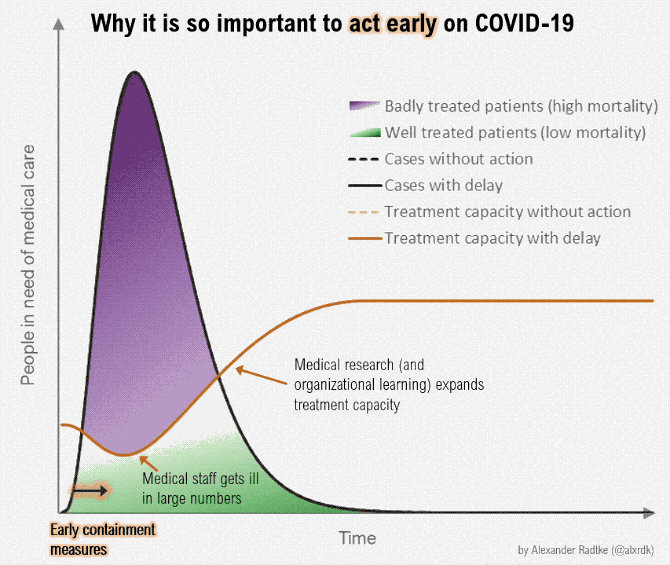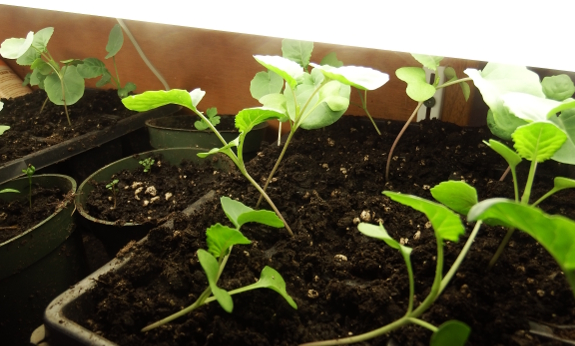
Social distance with a garden

It was a tough call given that there is only one community-spread case
in our state as of yesterday. But deeper reading suggests what we are
seeing is only the tip of the iceberg. While I'm at very low risk from
coronavirus, each person who contracts the disease spreads it to three
other people and mortality rates skyrocket each decade for folks over
60. Between us, Mark and I could be responsible for a grandmother's
death.
So we're going into social-distancing mode. We stocked up on a month's
worth of non-perishables earlier in the week and voted early yesterday.
The only reasons to leave home now are optional.
I'm keeping some of those optional outings. Hikes at the park seem very
safe, playing in my garden safer yet. Letting the neighbor twins come
down (with new, strict handwashing procedures they reluctantly agreed
to comply with, plus new surface-cleaning protocols after they leave)
seems like a worthwhile risk now that school is out and their worlds
are smaller. I'll likely still go down the road to buy eggs from
another neighbor, although we'll chat outdoors and keep our distance.
It feels a bit silly at this stage...but all of the experts I've heard
in the last week explain that social distancing is most effective when it feels silly. If we wait
until the ax looms, the health-care systems will be in danger of being
overwhelmed. (Don't forget that 5+ day lag between getting sick and
showing symptoms!)

So what am I telling you to do? All of the obvious stuff mentioned
above...and maybe also hurry up planting your spring garden.
Don't know where to start? Take a look at your region on this soil-temperature
map, then compare it to the minimum
germination temperatures for crops here. Easy and fast crops at
this time of year include lettuce, radishes, and most leafy
greens. These will be great for keeping the monotony of beans and
rice at bay!
High-calorie crops that can be planted now --- in case your stored
staples don't last the length of the outbreak --- include potatoes and
carrots and peas. For us, now is also the time to start a lot of summer
crops inside to jumpstart the frost-free date. Our broccoli sets are at
the two-leaf stage and I'll be filling a flat with tomato, basil, and
pepper seeds today.
I know that many of you can't simply hunker down in place. But if you
can stay home, just think how much more fun it will be to social
distance within a vibrant, food-filled garden.
And don't forget to wash your hands!
Want more in-depth information? Browse through our books.
Or explore more posts by date or by subject.
About us: Anna Hess and Mark Hamilton spent over a decade living self-sufficiently in the mountains of Virginia before moving north to start over from scratch in the foothills of Ohio. They've experimented with permaculture, no-till gardening, trailersteading, home-based microbusinesses and much more, writing about their adventures in both blogs and books.
Want to be notified when new comments are posted on this page? Click on the RSS button after you add a comment to subscribe to the comment feed, or simply check the box beside "email replies to me" while writing your comment.

Hi Anna,
It seems like a good time to publish a few page booklet about how to reliably grow edibles on your lawn.
warm regards to you both, John
I always used to say that you never make a medical mistake when viewing the case thru the Retro-Spectoscope. Here I have the advantage of reading your post with another month's data at hand.
A couple notable pieces of data: In Italy's experience, 55% of CoViD deaths occurred in those over 80 y/0, and75% in those over 70-- almost all of whom had multiple co-existent medical problems. One might suggest that those pts had a high probability of not surviving the next year, even without CoV.
The handful of studies completed at this point suggest the rate of CoV exposure is 50% or more in the general public, making the over=all death rate miniscule.
In NYC, 3% of CoViD pts presenting to the hosp made their way to the ICU and required mechanical ventilation-- only 1 in 5 of them survived, ie- the over-all death rate would have been increased by <1% if no ventilators were available at all..
...Considering the as yet unknown amount of personal, corporate and national economic hardship the sheltering efforts will have caused, it looks like a more prudent course would have been to not curtail normal activities..There would be a certain number of casualties-- inevitable in any war.
What if Ike had decided not to invade Normandy in 1944, knowing there would be a 30% casualty rate? Weren't the ultimate benefits of the sacrifice worth it? I think ultimately more lives will prove to have been ruined by business closures than deaths prevented.
Oh, BTW- when you "flatten the curve" the areas under the graphs stay the equal,ie- total number of cases doesn't change, only their rate of occurrence over time. When epidemics are allowed o run their natural course, a bell shaped curve is seen because the population develops herd immunity. For our CoViD experience, the bell shaped response is due to avoidance of exposure: once things are "opened up," a second wave is bound to occur.
Have a nice day